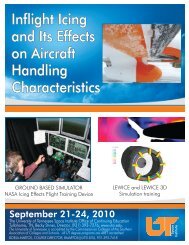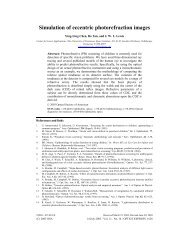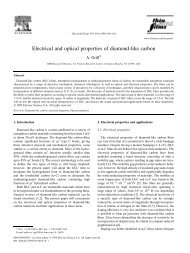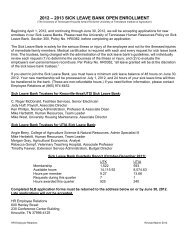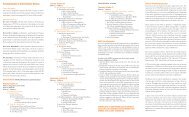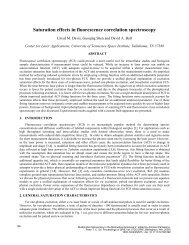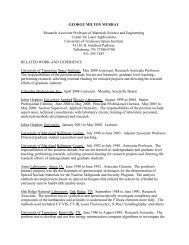Diamond-like carbon: state of the art
Diamond-like carbon: state of the art
Diamond-like carbon: state of the art
You also want an ePaper? Increase the reach of your titles
YUMPU automatically turns print PDFs into web optimized ePapers that Google loves.
430 A. Grill / <strong>Diamond</strong> and Related Materials 8 (1999) 428–434<br />
Roberston describes <strong>the</strong> structure <strong>of</strong> both DLC and taC internal stresses. These properties are directly correlated<br />
as being controlled by <strong>the</strong> energy <strong>of</strong> <strong>the</strong> p bonding <strong>of</strong> to <strong>the</strong> fraction <strong>of</strong> sp3 C in <strong>the</strong> films. The hardness <strong>of</strong><br />
<strong>the</strong> sp2 sites [20]. According to Robertson, <strong>the</strong> p bonding DLC films is in <strong>the</strong> range 10–30 GPa [28], with a<br />
<strong>of</strong> <strong>the</strong> sp2 <strong>carbon</strong> favors clustering <strong>of</strong> sp2 sites to corresponding Young’s modulus 6–10 times larger. The<br />
maximize <strong>the</strong> p-bonding energy. The sp2 sites can gain films are characterized by internal compressive stresses<br />
fur<strong>the</strong>r energy by forming sixfold planar ‘‘aromatic’’ in <strong>the</strong> range 0.5–7 GPa. The stresses can be reduced by<br />
rings and fusing <strong>the</strong> rings into larger graphitic clusters. incorporating N, Si, O or metals in <strong>the</strong> films [13,24],<br />
However, <strong>the</strong> energy gain resulting from increasing although <strong>the</strong> reduction in stresses is <strong>of</strong>ten associated<br />
cluster size beyond pairing is small, <strong>the</strong>refore, <strong>the</strong> cluster with a reduction in hardness and elastic modulus <strong>of</strong><br />
size remains small. For planar graphitic clusters <strong>of</strong> sp2 <strong>the</strong> films.<br />
<strong>carbon</strong>, <strong>the</strong> band gap was found to be given by The hardness <strong>of</strong> taC films can reach higher values (in<br />
E =6/M1/2 eV, where M is <strong>the</strong> number <strong>of</strong> sixfold rings<br />
g <strong>the</strong> range <strong>of</strong> 40–80 GPa) [8,22], and <strong>the</strong>ir Young’s<br />
in <strong>the</strong> cluster [25]. According to Robertson, <strong>the</strong> small<br />
modulus can reach values up to 900 GPa [10], but <strong>the</strong><br />
sp2 clusters cannot explain <strong>the</strong> small bandgap <strong>of</strong> DLC<br />
stress can also reach high values up to 13 GPa [22]. The<br />
and <strong>the</strong> small bandgap is caused by <strong>the</strong> fact that <strong>the</strong><br />
high internal stresses limit <strong>the</strong> thickness <strong>of</strong> films that<br />
distorted clusters have much smaller bandgaps [20]. The<br />
can be used for any application, <strong>of</strong>ten to less than 1 mm<br />
bandgap is <strong>the</strong>refore controlled by <strong>the</strong> distortion <strong>of</strong> <strong>the</strong><br />
thick. The stresses in taC have been reduced by incorpoclusters<br />
and not <strong>the</strong>ir size. Robertson also found that<br />
ration <strong>of</strong> metals [13] or by building multilayered struc<strong>the</strong><br />
optical gap <strong>of</strong> all types <strong>of</strong> diamond-<strong>like</strong> <strong>carbon</strong>,<br />
tures comprising s<strong>of</strong>t and hard films using a filtered<br />
hydrogenated or non-hydrogenated, depends mainly on<br />
<strong>the</strong> sp2 fraction in <strong>the</strong> films and decreases with increastion<br />
[29,30]. The bias <strong>of</strong> <strong>the</strong> substrate was changed<br />
vacuum arc and varying <strong>the</strong> ion energy during composi-<br />
ing sp2 fraction. Non-hydrogenated taC, which has<br />
small sp2 fractions, has a very rigid network, while<br />
between −100 eV (to obtain <strong>the</strong> hardest layers with an<br />
hydrogenated DLC has a s<strong>of</strong>ter polymeric network, yet sp3 fraction <strong>of</strong> 85% and hardness <strong>of</strong> 60 GPa) and −2kV<br />
both types <strong>of</strong> films have similar bandgaps.<br />
(to deposit s<strong>of</strong>t films with an sp3 fraction <strong>of</strong> 39%) [30].<br />
The multilayered structures had hardness (40–23 GPa)<br />
3.2. Characterization<br />
and modulus (350–245 GPa), corresponding to <strong>the</strong> fraction<br />
<strong>of</strong> <strong>the</strong> hard and s<strong>of</strong>t layers, and <strong>the</strong> stresses in <strong>the</strong><br />
The structural characterization <strong>of</strong> diamond-<strong>like</strong> films were reduced in <strong>the</strong> multilayered films from<br />
<strong>carbon</strong> films is complicated by <strong>the</strong>ir amorphous nature. 10.5 GPa, for <strong>the</strong> hard film, to 3.8 GPa, for <strong>the</strong> film<br />
High resolution nuclear magnetic resolution (NMR) containing a 90% s<strong>of</strong>t fraction.<br />
spectroscopy with its recent refinements [21] appears to<br />
be <strong>the</strong> best technique for characterization <strong>of</strong> <strong>the</strong> <strong>carbon</strong> 3.4. Material stability<br />
hybridization <strong>of</strong> hydrogenated DLC. Fourier transform<br />
infrared spectroscopy (FTIR) is still being used by some Both <strong>the</strong> hydrogenated and non-hydrogenated DLC<br />
authors to quantify <strong>the</strong> <strong>carbon</strong> hybridization ratios and are metastable materials and <strong>the</strong>ir structures will change<br />
hydrogen content in DLC films, in spite <strong>of</strong> <strong>the</strong> fact that towards graphite-<strong>like</strong> <strong>carbon</strong> by ei<strong>the</strong>r <strong>the</strong>rmal activait<br />
has been shown that <strong>the</strong> technique can give erroneous tion or irradiation with energetic photons or p<strong>art</strong>icles.<br />
information [26]. Electron energy loss spectroscopy Heating <strong>of</strong> hydrogenated DLC films results in <strong>the</strong> loss<br />
(EELS) has become <strong>the</strong> established method to measure <strong>of</strong> hydrogen and CH species, st<strong>art</strong>ing at about 400 °C,<br />
<strong>the</strong> sp2 bonding fraction in non-hydrogenated taC [20].<br />
x<br />
or even lower, depending on <strong>the</strong> deposition conditions<br />
The technique is, however, not suitable for DLC, which<br />
and <strong>the</strong> dopant contained in <strong>the</strong> films [3,16,17]. This<br />
is sensitive to irradiation with an electron beam [27].<br />
causes changes in <strong>the</strong> dimensions and properties <strong>of</strong> <strong>the</strong><br />
FTIR can be used for qualitative characterization <strong>of</strong><br />
material and limits <strong>the</strong> use <strong>of</strong> DLC in applications<br />
different bonds in hydrogenated diamond-<strong>like</strong> <strong>carbon</strong><br />
involving temperatures above 400 °C. The temperature<br />
films or <strong>the</strong>ir modifications. Film compositions can be<br />
at which changes take place in <strong>the</strong> DLC films appears<br />
determined by Ru<strong>the</strong>rford backscattering (RBS) analyto<br />
be correlated to <strong>the</strong> power used for <strong>the</strong> preparation<br />
sis <strong>of</strong> C and heavier elements and forward recoil elastic<br />
scattering (FRES) for H concentrations. Mechanical<br />
<strong>of</strong> <strong>the</strong> films [16]. The <strong>the</strong>rmal instability <strong>of</strong> DLC films<br />
properties are usually determined by nanoindentation<br />
is generally associated with <strong>the</strong> loss <strong>of</strong> hydrogen, result-<br />
measurements for hardness and Young’s modulus detersp2-bonded<br />
network.<br />
ing in a collapse <strong>of</strong> <strong>the</strong> structure into a mostly<br />
mination and measurements <strong>of</strong> radius <strong>of</strong> curvature <strong>of</strong><br />
coated substrates for stress determination [3,22].<br />
It has been reported that <strong>the</strong>rmal activation can also<br />
induce changes in taC films and cause <strong>the</strong> conversion <strong>of</strong><br />
3.3. Mechanical properties<br />
some sp3 <strong>carbon</strong> bonds to sp2 bonds [31]. The onset <strong>of</strong><br />
relaxation st<strong>art</strong>ed at temperatures as low as 100 °C and<br />
<strong>Diamond</strong>-<strong>like</strong> <strong>carbon</strong> films are characterized by high near full relaxation has been observed at 600 °C. An<br />
hardness and a high elastic modulus, but also by high activation energy in <strong>the</strong> range <strong>of</strong> 1–3 eV has been



